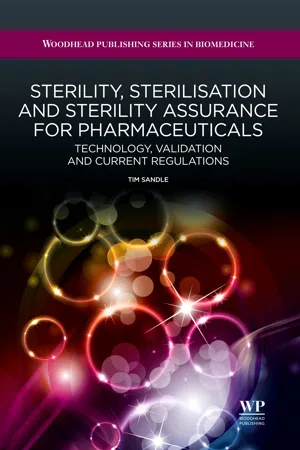
Sterility, Sterilisation and Sterility Assurance for Pharmaceuticals
Technology, Validation and Current Regulations
- 362 pages
- English
- ePUB (mobile friendly)
- Available on iOS & Android
Sterility, Sterilisation and Sterility Assurance for Pharmaceuticals
Technology, Validation and Current Regulations
About this book
Failure to adequately control any microbial challenge associated within process or product by robust sterilisation will result in a contaminated marketed product, with potential harm to the patient. Sterilisation is therefore of great importance to healthcare and the manufacturers of medical devices and pharmaceuticals. Sterility, sterilisation and sterility assurance for pharmaceuticals examines different means of rendering a product sterile by providing an overview of sterilisation methods including heat, radiation and filtration. The book outlines and discusses sterilisation technology and the biopharmaceutical manufacturing process, including aseptic filling, as well as aspects of the design of containers and packaging, as well as addressing the cleanroom environments in which products are prepared. Consisting of 18 chapters, the book comprehensively covers sterility, sterilisation and microorganisms; pyrogenicity and bacterial endotoxins; regulatory requirements and good manufacturing practices; and gamma radiation. Later chapters discuss e-beam; dry heat sterilisation; steam sterilisation; sterilisation by gas; vapour sterilisation; and sterile filtration, before final chapters analyse depyrogenation; cleanrooms; aseptic processing; media simulation; biological indicators; sterility testing; auditing; and new sterilisation techniques.- Covers the main sterilisation methods of physical removal, physical alteration and inactivation- Includes discussion of medical devices, aseptically filled products and terminally sterilised products- Describes bacterial, pyrogenic, and endotoxin risks to devices and products
Frequently asked questions
- Essential is ideal for learners and professionals who enjoy exploring a wide range of subjects. Access the Essential Library with 800,000+ trusted titles and best-sellers across business, personal growth, and the humanities. Includes unlimited reading time and Standard Read Aloud voice.
- Complete: Perfect for advanced learners and researchers needing full, unrestricted access. Unlock 1.4M+ books across hundreds of subjects, including academic and specialized titles. The Complete Plan also includes advanced features like Premium Read Aloud and Research Assistant.
Please note we cannot support devices running on iOS 13 and Android 7 or earlier. Learn more about using the app.
Information
Sterility, sterilisation and microorganisms
Abstract:
1.1 Introduction
1.2 Sterility
1.2.1 Defining sterility
Table of contents
- Cover image
- Title page
- Table of Contents
- Copyrights
- Dedication
- List of figures and tables
- Preface
- About the author
- Introduction
- Chapter 1: Sterility, sterilisation and microorganisms
- Chapter 2: Pyrogenicity bacterial endotoxin
- Chapter 3: Regulatory requirements and Good Manufacturing Practices (GMP)
- Chapter 4: Gamma radiation
- Chapter 5: Electron beam processing
- Chapter 6: Dry heat sterilisation
- Chapter 7: Steam sterilisation
- Chapter 8: Gaseous sterilisation
- Chapter 9: Hydrogen peroxide vapour sterilisation
- Chapter 10: Sterilisation by filtration
- Chapter 11: Other methods of sterilisation
- Chapter 12: Depyrogenation and endotoxin
- Chapter 13: Cleanrooms, isolators and cleanroom technology
- Chapter 14: Aseptic processing filling
- Chapter 15: Media simulation trials
- Chapter 16: Cleaning disinfection of sterile processing facilities
- Chapter 17: Biological indicators
- Chapter 18: The Sterility Test
- Chapter 19: Investigating sterility test failures
- Chapter 20: Auditing sterilisation processes facilities
- Conclusion
- Index